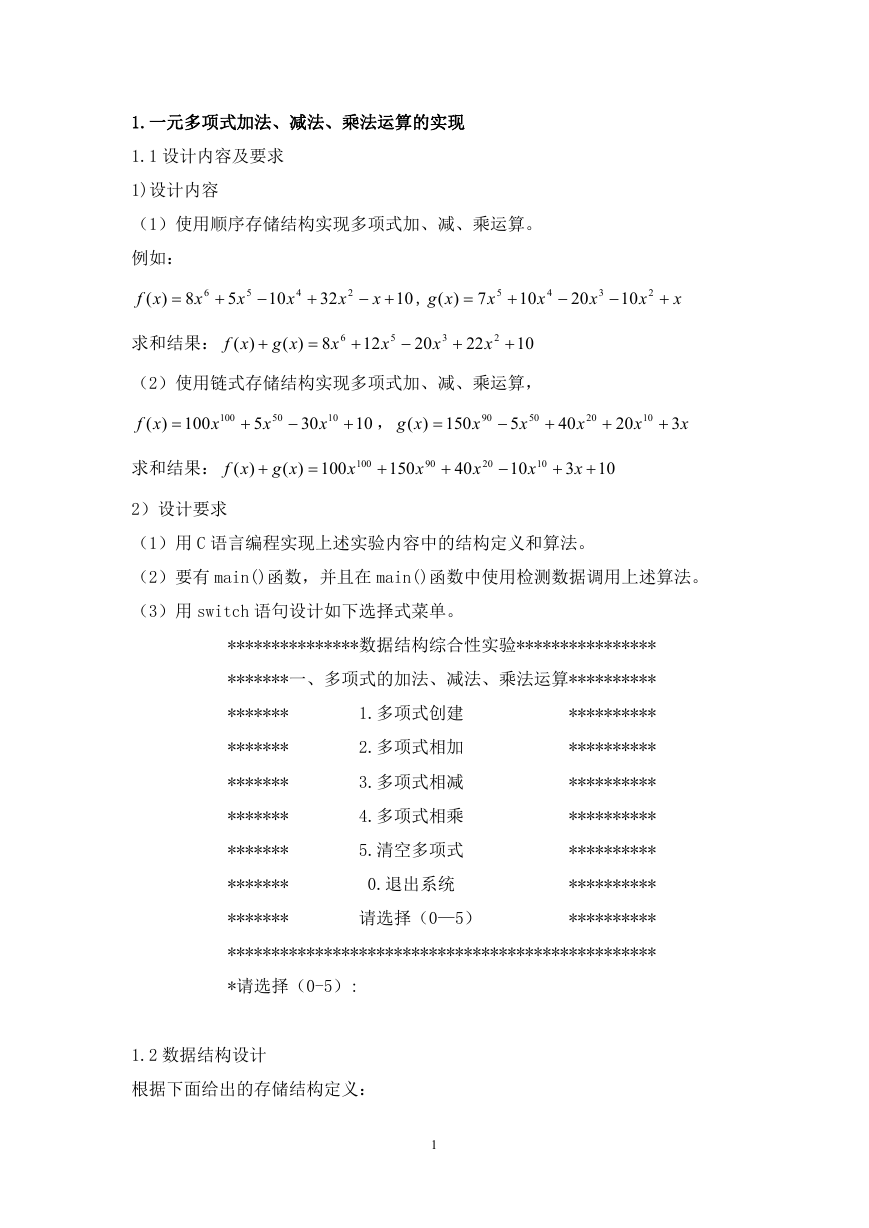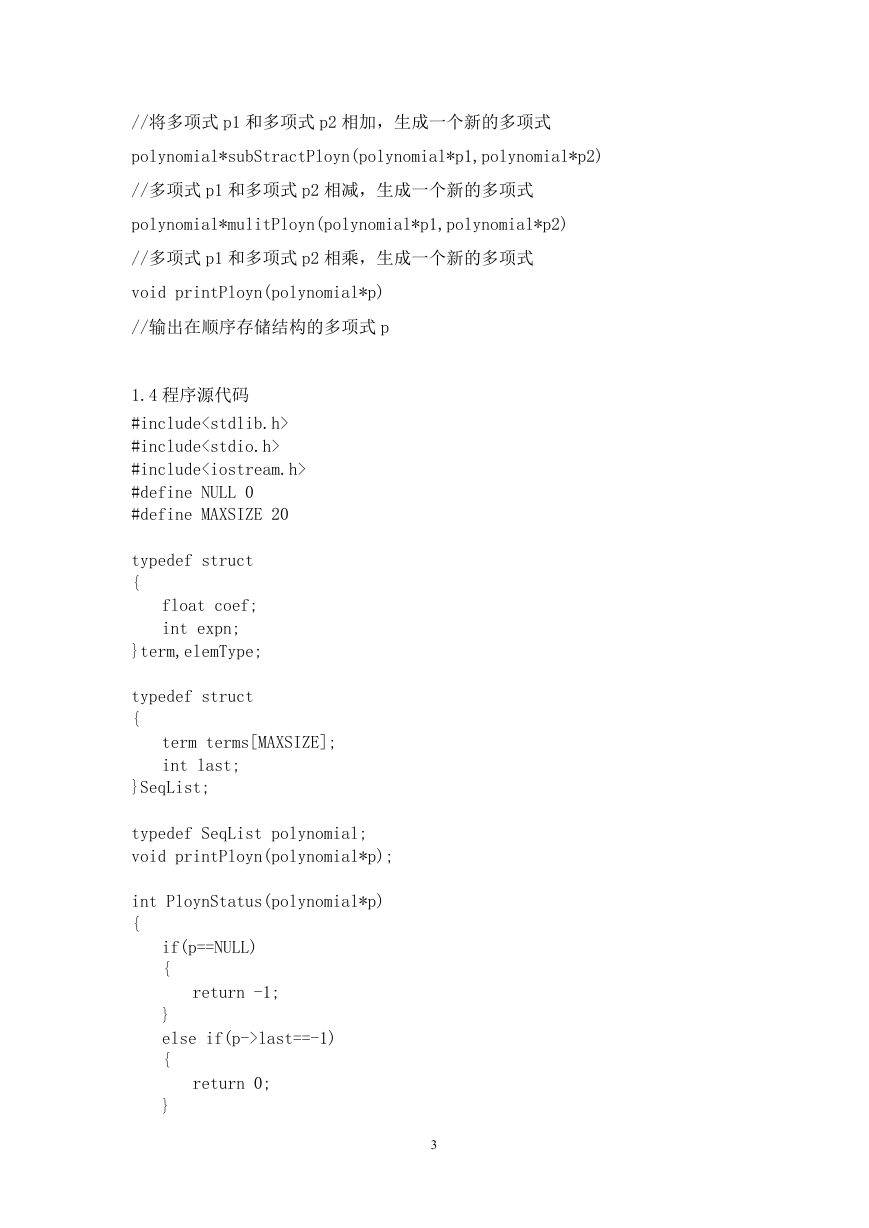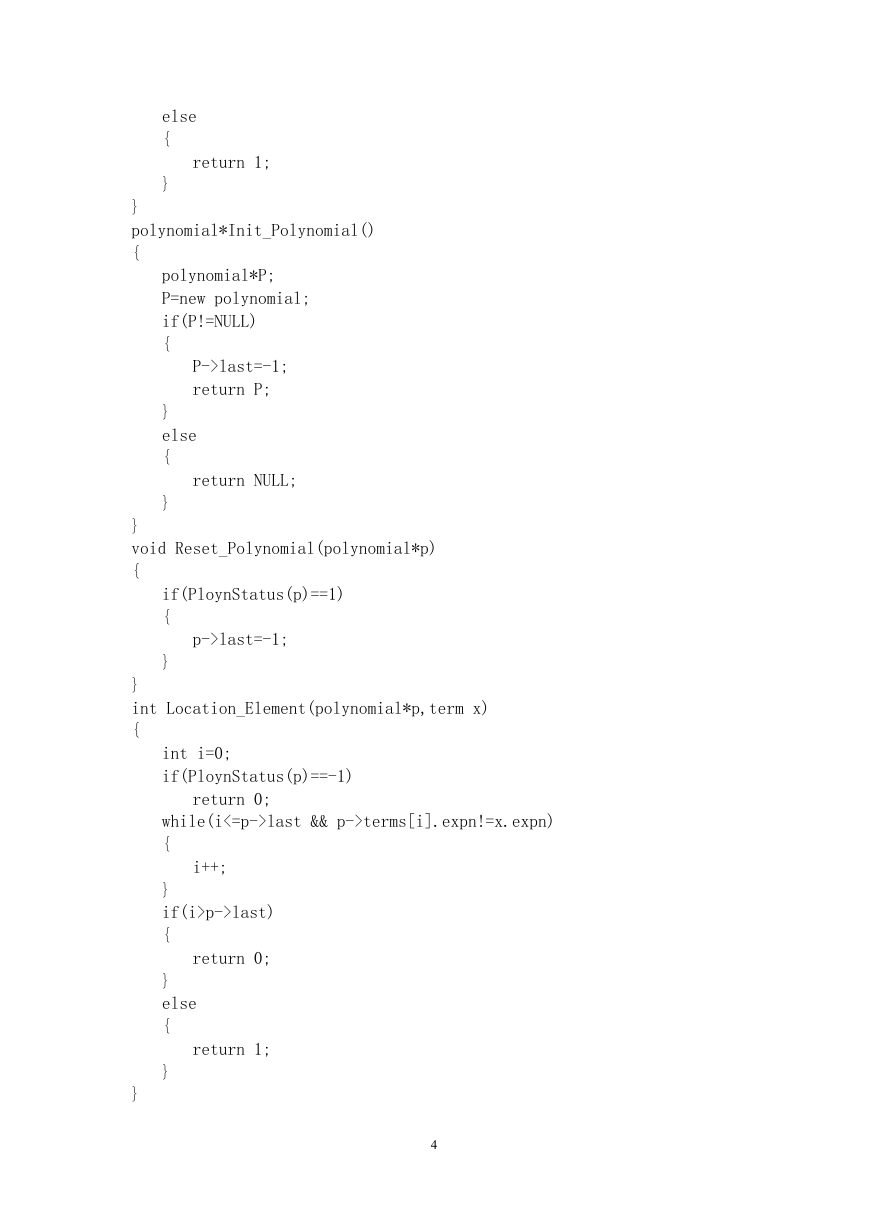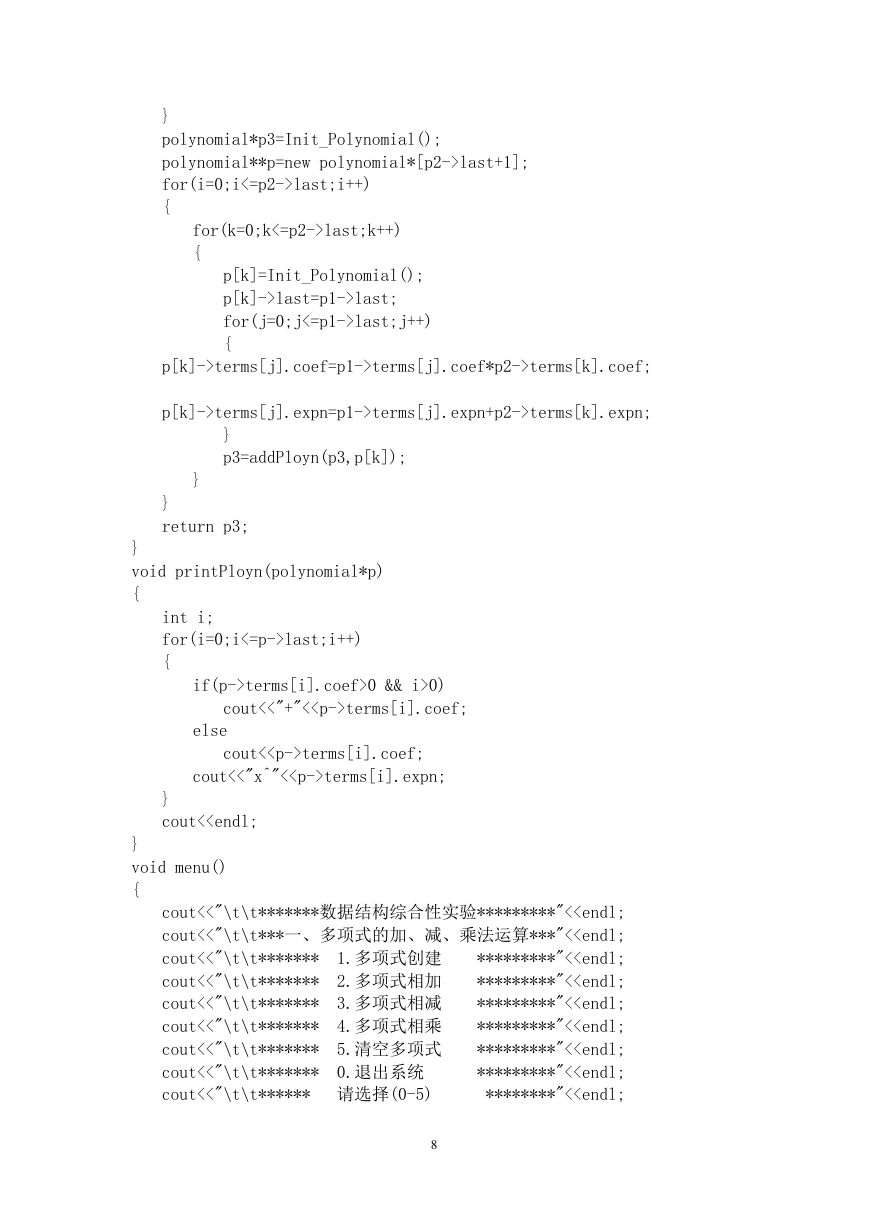1.一元多项式加法、减法、乘法运算的实现
1.1 设计内容及要求
1)设计内容
(1)使用顺序存储结构实现多项式加、减、乘运算。
例如:
)(
xf
6
8
x
5
5
x
10
x
4
32
x
2
x
10
,
)(
xg
5
7
x
10
x
4
3
20
x
10
x
2
x
求和结果:
)(
xf
)(
xg
6
8
x
12
x
5
3
20
x
2
22
x
10
(2)使用链式存储结构实现多项式加、减、乘运算,
)(
xf
100
x
100
5
x
50
30
x
10
10
,
)(
xg
150
x
90
5
x
50
40
x
20
20
x
10
3
x
求和结果:
)(
xf
)(
xg
100
x
100
150
x
90
40
x
20
10
x
10
3
x
10
2)设计要求
(1)用 C 语言编程实现上述实验内容中的结构定义和算法。
(2)要有 main()函数,并且在 main()函数中使用检测数据调用上述算法。
(3)用 switch 语句设计如下选择式菜单。
***************数据结构综合性实验****************
*******一、多项式的加法、减法、乘法运算**********
*******
*******
*******
*******
*******
*******
*******
1.多项式创建
2.多项式相加
3.多项式相减
4.多项式相乘
5.清空多项式
0.退出系统
请选择(0—5)
**********
**********
**********
**********
**********
**********
**********
*************************************************
*请选择(0-5):
1.2 数据结构设计
根据下面给出的存储结构定义:
1
�
#define MAXSIZE 20
//定义线性表最大容量
//定义多项式项数据类型
typedef struct
{
float coef;
int expn;
}term,elemType;
typedef struct
{
//系数
//指数
term terms[MAXSIZE];
//线性表中数组元素
int last;
//指向线性表中最后一个元素位置
}SeqList;
typedef SeqList polynomial;
1.3 基本操作函数说明
polynomial*Init_Polynomial();
//初始化空的多项式
int PloynStatus(polynomial*p)
//判断多项式的状态
int Location_Element(polynomial*p,term x)
在多项式 p 中查找与 x 项指数相同的项是否存在
int Insert_ElementByOrder(polynomial*p,term x)
//在多项式 p 中插入一个指数项 x
int CreatePolyn(polynomial*P,int m)
//输入 m 项系数和指数,建立表示一元多项式的有序表 p
char compare(term term1,term term2)
//比较指数项 term1 和指数项 term2
polynomial*addPloyn(polynomial*p1,polynomial*p2)
2
�
//将多项式 p1 和多项式 p2 相加,生成一个新的多项式
polynomial*subStractPloyn(polynomial*p1,polynomial*p2)
//多项式 p1 和多项式 p2 相减,生成一个新的多项式
polynomial*mulitPloyn(polynomial*p1,polynomial*p2)
//多项式 p1 和多项式 p2 相乘,生成一个新的多项式
void printPloyn(polynomial*p)
//输出在顺序存储结构的多项式 p
1.4 程序源代码
#include
#include
#include
#define NULL 0
#define MAXSIZE 20
typedef struct
{
float coef;
int expn;
}term,elemType;
typedef struct
{
term terms[MAXSIZE];
int last;
}SeqList;
typedef SeqList polynomial;
void printPloyn(polynomial*p);
int PloynStatus(polynomial*p)
{
if(p==NULL)
{
return -1;
}
else if(p->last==-1)
{
return 0;
}
3
�
else
{
return 1;
}
}
polynomial*Init_Polynomial()
{
polynomial*P;
P=new polynomial;
if(P!=NULL)
{
P->last=-1;
return P;
}
else
{
return NULL;
}
}
void Reset_Polynomial(polynomial*p)
{
if(PloynStatus(p)==1)
{
p->last=-1;
}
}
int Location_Element(polynomial*p,term x)
{
int i=0;
if(PloynStatus(p)==-1)
return 0;
while(i<=p->last && p->terms[i].expn!=x.expn)
{
i++;
}
if(i>p->last)
{
return 0;
}
else
{
return 1;
}
}
4
�
int Insert_ElementByOrder(polynomial*p,term x)
{
int j;
if(PloynStatus(p)==-1)
return 0;
if(p->last==MAXSIZE-1)
{
cout<<"The polym is full!"<
last;
while(p->terms[j].expn=0)
{
p->terms[j+1]=p->terms[j];
j--;
}
p->terms[j+1]=x;
p->last++;
return 1;
}
int CreatePolyn(polynomial*P,int m)
{
float coef;
int expn;
term x;
if(PloynStatus(P)==-1)
return 0;
if(m>MAXSIZE)
{
printf("顺序表溢出\n");
return 0;
}
else
{
printf("请依次输入%d 对系数和指数...\n",m);
for(int i=0;i}
}
return 1;
}
char compare(term term1,term term2)
{
if(term1.expn>term2.expn)
{
return'>';
}
else if(term1.expn':
p3->terms[k++]=p1->terms[i++];
p3->last++;
break;
case'<':
p3->terms[k++]=p2->terms[j++];
p3->last++;
break;
case'=':
if(p1->terms[i].coef+p2->terms[j].coef!=0)
6
�
{
p3->terms[k].coef=p1->terms[i].coef+p2->terms[j].coef;
p3->terms[k].expn=p1->terms[i].expn;
k++;
p3->last++;
}
i++;
j++;
}
}
while(i<=p1->last)
{
p3->terms[k++]=p1->terms[i++];
p3->last++;
}
return p3;
}
polynomial*subStractPloyn(polynomial*p1,polynomial*p2)
{
int i;
i=0;
if((PloynStatus(p1)!=1)||(PloynStatus(p2)!=1))
{
return NULL;
}
polynomial*p3=Init_Polynomial();
p3->last=p2->last;
for(i=0;i<=p2->last;i++)
{
p3->terms[i].coef=-p2->terms[i].coef;
p3->terms[i].expn=p2->terms[i].expn;
}
p3=addPloyn(p1,p3);
return p3;
}
polynomial*mulitPloyn(polynomial*p1,polynomial*p2)
{
int i;
int j;
int k;
i=0;
if((PloynStatus(p1)!=1)||(PloynStatus(p2)!=1))
{
return NULL;
7
�
}
polynomial*p3=Init_Polynomial();
polynomial**p=new polynomial*[p2->last+1];
for(i=0;i<=p2->last;i++)
{
for(k=0;k<=p2->last;k++)
{
p[k]=Init_Polynomial();
p[k]->last=p1->last;
for(j=0;j<=p1->last;j++)
{
p[k]->terms[j].coef=p1->terms[j].coef*p2->terms[k].coef;
p[k]->terms[j].expn=p1->terms[j].expn+p2->terms[k].expn;
}
p3=addPloyn(p3,p[k]);
}
}
return p3;
}
void printPloyn(polynomial*p)
{
int i;
for(i=0;i<=p->last;i++)
{
if(p->terms[i].coef>0 && i>0)
cout<<"+"<
terms[i].coef;
else
cout<terms[i].coef;
cout<<"x^"<terms[i].expn;
}
cout<
















 2023年江西萍乡中考道德与法治真题及答案.doc
2023年江西萍乡中考道德与法治真题及答案.doc 2012年重庆南川中考生物真题及答案.doc
2012年重庆南川中考生物真题及答案.doc 2013年江西师范大学地理学综合及文艺理论基础考研真题.doc
2013年江西师范大学地理学综合及文艺理论基础考研真题.doc 2020年四川甘孜小升初语文真题及答案I卷.doc
2020年四川甘孜小升初语文真题及答案I卷.doc 2020年注册岩土工程师专业基础考试真题及答案.doc
2020年注册岩土工程师专业基础考试真题及答案.doc 2023-2024学年福建省厦门市九年级上学期数学月考试题及答案.doc
2023-2024学年福建省厦门市九年级上学期数学月考试题及答案.doc 2021-2022学年辽宁省沈阳市大东区九年级上学期语文期末试题及答案.doc
2021-2022学年辽宁省沈阳市大东区九年级上学期语文期末试题及答案.doc 2022-2023学年北京东城区初三第一学期物理期末试卷及答案.doc
2022-2023学年北京东城区初三第一学期物理期末试卷及答案.doc 2018上半年江西教师资格初中地理学科知识与教学能力真题及答案.doc
2018上半年江西教师资格初中地理学科知识与教学能力真题及答案.doc 2012年河北国家公务员申论考试真题及答案-省级.doc
2012年河北国家公务员申论考试真题及答案-省级.doc 2020-2021学年江苏省扬州市江都区邵樊片九年级上学期数学第一次质量检测试题及答案.doc
2020-2021学年江苏省扬州市江都区邵樊片九年级上学期数学第一次质量检测试题及答案.doc 2022下半年黑龙江教师资格证中学综合素质真题及答案.doc
2022下半年黑龙江教师资格证中学综合素质真题及答案.doc